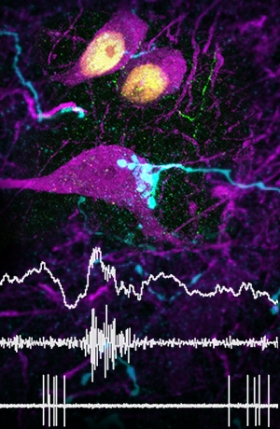Nat. Neurosci. 2013;16(12):1802-11. 10.1038/nn.3550
Network state-dependent inhibition of identified hippocampal CA3 axo-axonic cells in vivo.
Full text PDF download:
Abstract:
Hippocampal sharp waves are population discharges initiated by an unknown mechanism in pyramidal cell networks of CA3. Axo-axonic cells (AACs) regulate action potential generation through GABAergic synapses on the axon initial segment. We found that CA3 AACs in anesthetized rats and AACs in freely moving rats stopped firing during sharp waves, when pyramidal cells fire most. AACs fired strongly and rhythmically around the peak of theta oscillations, when pyramidal cells fire at low probability. Distinguishing AACs from other parvalbumin-expressing interneurons by their lack of detectable SATB1 transcription factor immunoreactivity, we discovered a somatic GABAergic input originating from the medial septum that preferentially targets AACs. We recorded septo-hippocampal GABAergic cells that were activated during hippocampal sharp waves and projected to CA3. We hypothesize that inhibition of AACs, and the resulting subcellular redistribution of inhibition from the axon initial segment to other pyramidal cell domains, is a necessary condition for the emergence of sharp waves promoting memory consolidation.